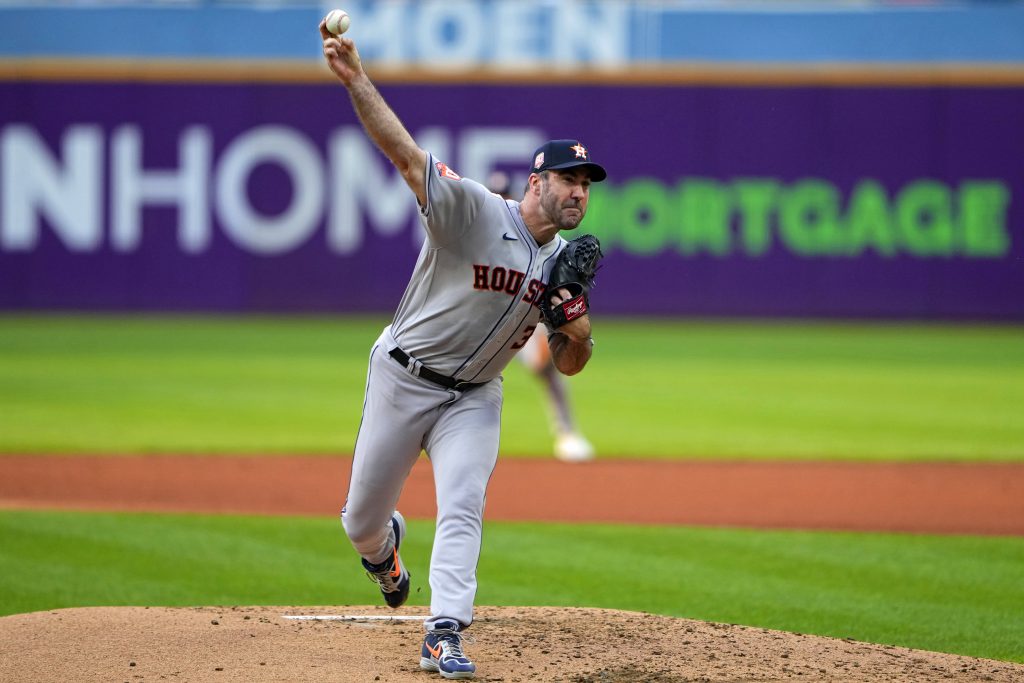
Justin Verlander breezed through the Guardians lineup tonight, tossing six innings of scoreless ball. It was another dominant performance in a season full of them for the AL Cy Young award contender, and today’s start also marked a notable contractual development. Verlander reached 130 innings on the season, meaning he’s officially vested a $25MM player option for the 2023 campaign.
Verlander is trending towards foregoing that option, as he’s in position to handily surpass a $25MM average annual value as a free agent. The nine-time All-Star commanded an identical salary this year on the heels of a season in which he didn’t pitch as he rehabbed from 2020 Tommy John surgery. Amidst one of the best seasons of a Hall of Fame career, Verlander is trending towards a massive raise. That’s particularly true since he received and rejected a qualifying offer last winter, meaning the Astros cannot offer another QO next offseason. A signing club thus won’t have to forfeit any draft pick or international signing bonus space this time around. Barring injury or a completely out-of-the-blue collapse in the final couple months, he’ll shatter a $25MM guarantee on the free agent market.
After tonight’s start, Verlander now carries a major league best 1.73 ERA. His 25.5% strikeout rate isn’t at the elite 35.1% level he posted between 2018-20, but it’s still four points above the MLB average for starters. With league-best run prevention, Verlander’s dip in strikeouts isn’t likely to have too significant an effect on his value on the open market. That’s particularly true since his 95 MPH average fastball velocity has remained intact after the elbow surgery, and he’s continued to spin both his fastball and breaking pitches at a high-end level. Verlander also owns some of the best command in the sport, and the 2011 AL MVP has proven capable of thriving on the biggest stage. He carries a career 3.40 ERA in 187 2/3 postseason innings, and he’ll have an opportunity to build on that resume with Houston this October.
Verlander’s exceptional track record sets up one of the more fascinating free agent cases of the upcoming offseason. He’s clearly reestablished himself as one of the sport’s best pitchers, the kind of ace clubs would be happy to trot out in the opening game of a playoff series. A new deal will begin with his age-40 campaign, however, setting him up for a short-term contract with a massive annual salary.
The obvious comparison point is the record-setting contract scored by his former teammate Max Scherzer last winter. The three-time Cy Young winner signed a three-year, $130MM deal with the Mets. That obliterated the previous all-time high annual salary, with Scherzer’s $43.333MM annual payout topping any previous contract’s yearly salary by more than $7MM. Scherzer was coming off a 179 1/3 inning, 2.46 ERA campaign in which he struck out 34.1% of opponents between the Nationals and Dodgers. That better swing-and-miss stuff might tip the nod in Scherzer’s favor, but Verlander and his representatives at ISE Baseball seem likely to try to top that AAV record — particularly if he holds a sub-2.00 ERA all year. Even if he doesn’t quite hit Scherzer’s heights, beating the $36MM annual salary that ranks second all-time feels attainable for Verlander.
It’ll be equally interesting to see the length of the contract Verlander might receive. Scherzer’s deal began with his age-37 campaign and takes him through 39, Verlander’s current age. With Verlander still at the top of his game, a multi-year pact feels likely. Whether a team would go to three years and sign him through age-42 remains to be seen.
The upcoming starting pitching market features a few high-end arms, although most have injury or age concerns. With Joe Musgrove agreeing to a five-year extension to stick in his hometown San Diego, players like Jacob deGrom, Carlos Rodón and Verlander look to be the top hurlers on the market (assuming all three trigger opt-out clauses in their contracts).
Nathan Eovaldi and Chris Bassitt are above-average starters but each are already in their mid-30s. Noah Syndergaard has looked like a solid mid-rotation arm but isn’t throwing as hard or missing as many bats as he did at his peak with the Mets. Sean Manaea has an underwhelming 4.24 ERA on the year, although he’s typically a solid mid-rotation type. Mike Clevinger will be entering his age-32 season and missed all of last year rehabbing from Tommy John surgery. Zach Eflin is one of the younger arms available and generally solid when healthy, but he’s dealt with recurring knee injuries in his career that have again arisen this season. Clayton Kershaw seemingly limited his market last winter with geographic restrictions. It’s a class that won’t be lacking for star power, but there’s also a fair bit of uncertainty with most of the veteran hurlers who’ll be out there.
Image courtesy of USA Today Sports.
Credit : Source link






